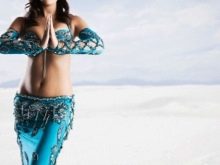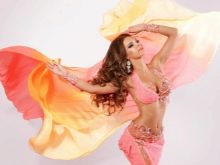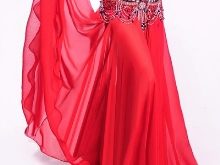Eastern dance
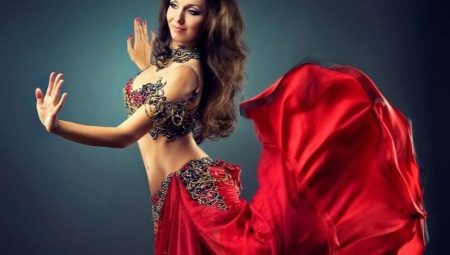
Oriental dances are a culture that beckons with its femininity, seductiveness and spectacular costumes. Even the Slavs, whose traditions are completely different, love these fabulous pictures of attractive long-haired dancers in unusually beautiful outfits. A big plus of oriental dances is that you can learn them even in adulthood, literally from scratch.
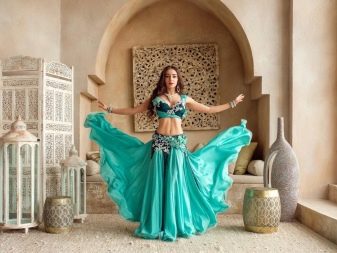
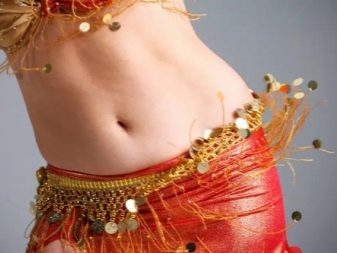
What it is?
Oriental dances, belly dance, "belly dance" - all these are names of approximately the same direction. By the way, doctors treat them very positively, because behind the rotations, circles and lunges, downward bends there is activity that helps to "disperse the blood." This is a very simplified explanation, but the fact that stagnant processes can be prevented by oriental dances is a fact.
The considered dance direction is considered a huge cultural layer of the Middle East. He does not have a country-owner, a monopolist, more than one, precisely distinguished progenitor. It developed in several places at once: from Egypt to Turkey, from Lebanon to Jordan, etc.
It is known that the first mentions refer to Tibet, but more complete information about oriental dances is associated with Ancient Egypt, where they were cult. With the development of travel and trade, dance began to spread throughout the world.
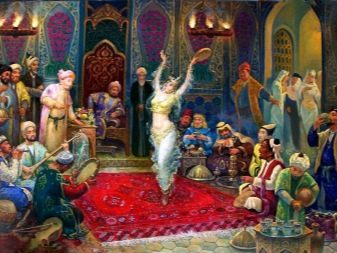
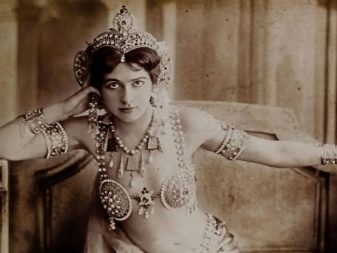
Those oriental movements that we see now are already a popularized and adapted version of the source, they are more frank, do not bear the character of a cult and look more like a show than something intimate. Moreover, this dance cannot be compared with those areas where exhausting training, work through strength, weight control are integral components. In oriental dances, movements should be a joy, in action on the stage there should be lightness - no tension or sports excitement. There are a lot of oriental dances, they can seriously differ from each other: in one, jumping and shaking will prevail, in the other - wriggling movements with arms and body, etc.
Beledi is a folk dance, and raks sharki is simply oriental. And all these names, features make up a huge world of dance, which can be studied all your life. At the same time, it is not a fact that you can comprehend everything and learn everything. But it's worth starting, because oriental dances liberate, help to feel feminine, to get to know your body better.
They also give happy (albeit difficult) moments of working on a stage costume, which also mirrors a woman's personality, reflects her passions and vision of the beauty of the world. In a word, it is really very interesting.
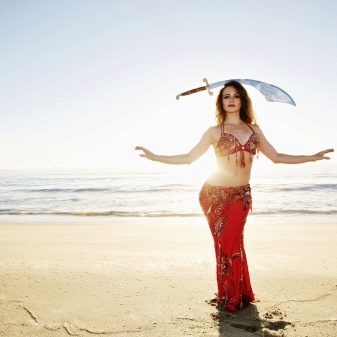

Views
Firstly, the dance is divided into authentic folk and stage folk. In the first case, the requirements are much simpler, it is performed at folk festivals by ordinary people. As a rule, it does not include complex elements. Mass character and well-remembered movements are important here. In stage dance, everything is more difficult, because it is performed by professional dancers.
It contains authentic movements, as well as elements of the costume, but still the stage format provides for some adaptation. In this dance, the choreography is built very clearly, in it an expressive drawing, entertainment is obligatory. Secondly, the main dances of the regions differ in manner, speed, temperament, and accent movements.
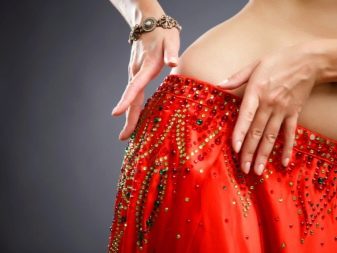
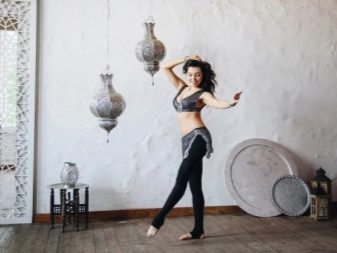
Let's list the popular types of oriental dance.
- Haggala. Comes from the word "leap". At the culmination of the holiday (wedding), men go out into the courtyard in groups. There they will clap, beckoning to the dancer. This is either a professional artist or a teenage girl from the bride's family. She will go where the clapping is louder. In her hand can be either a handkerchief or a stick. This is a fast dance, even very much, it is associated with active hip movements. They dance it today in a long dress with an abundance of flounces.
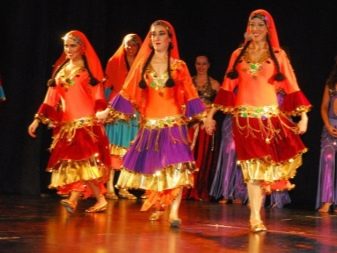
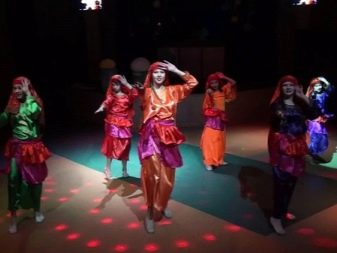
- Saidi. This is the name of a folk dance with a cane, lively and energetic, in which you can balance it on your chest, head or hips. However, you can do without a cane - there would be a recognizable rhythm. There are many jumps and passes in the dance, with one hand near the head, the other extended forward. Everybody dances it.
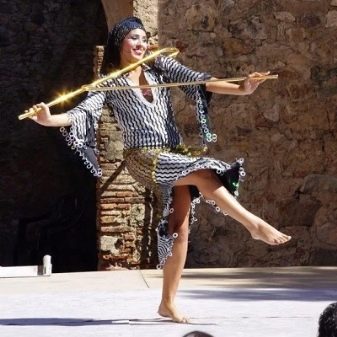
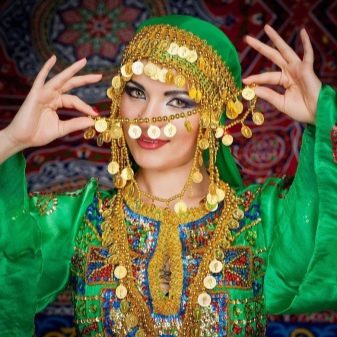
- Beledi. It was danced in many Egyptian villages, but only in the house of women and for them. This is a solo performance, what is its main difference from folklore directions. The dance is fun and flirtatious, but it looks a little heavy, it is usually performed on a full foot. Basic movements fall on the hips, there are no layers, the manner should be simple, without academicism. It is performed barefoot in a white galabey with a hip scarf and headscarf.
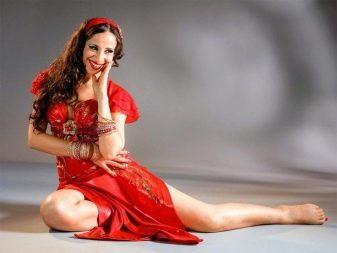
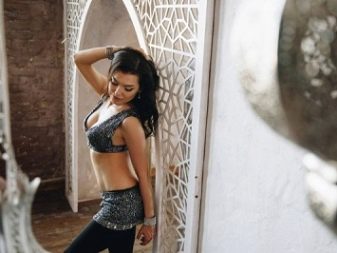
- Fellahi. A light and energetic rhythm with vocal accompaniment requires the dancer to repeat the lyrics of the song with movements. The dance imitates the work of farmers who harvest crops or wear a jug on their heads. It is performed in a long loose dress, rather wide at the bottom, decorated with ruffles, and also in a headscarf.
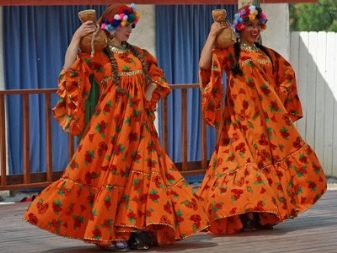
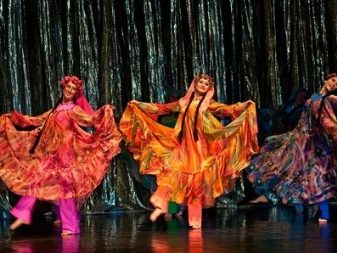
- Gawaysi. This is the name of the gypsy Egyptian tribe, whose women were considered the most beautiful. The compositions are performed on folk instruments, among them there will be cymbals. Men usually play and women dance. The set of movements is not very wide, everything is monotonous, but this dance-shaking could last for hours, which delighted the viewer. The suit assumes wide trousers, a caftan, a shirt, a fringed hip shawl. And the dancer had ribbons and beads in her hair.
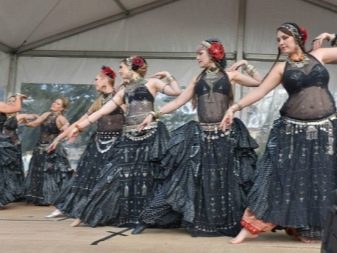

- Nubia. Fast, nothing else resembling. This dance is considered a group dance, built largely on graceful movements of the hips and hands. A tambourine and a reed plate are used in it.The female image is represented by a long, rather closed and loose dress, and her hair is tied with a scarf that hangs down the wall.
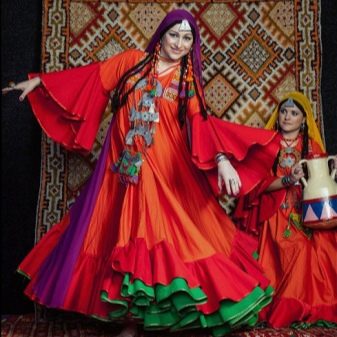
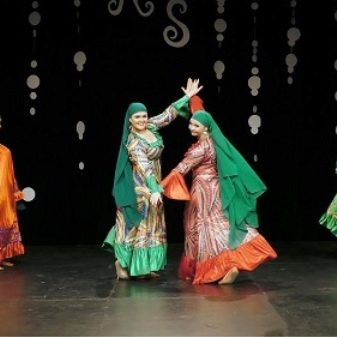
- Dabka. Folklore, brilliant, temperamental style, always performed at festivals. It is usually danced in a male circle, in a group. Steps are fast, various jumps prevail in it. And the rosary, quickly rotating in his hand, becomes traditional for him. It is performed in wide trousers tucked into boots with heels, a vest and a headdress.

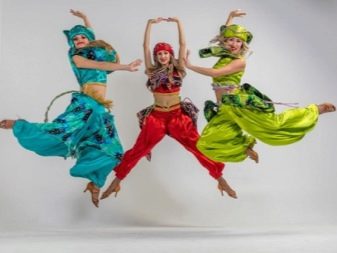
- Khaliji. Traditional music of the Persian Gulf. The dancer in it allows herself to clap, snap her fingers. It is also a dance performed by women, and it is addressed to them. In it, the beauty of the costume and the hair of the performer are much more important than the technical complexity. Most of the movement is related to the upper torso and steps that mimic camel stride. Excellent in dance and quick shaking of the shoulders, and tossing hair. It is performed in a long brilliant tunic decorated with embroidery. Long gold jewelry will also be an indispensable attribute.
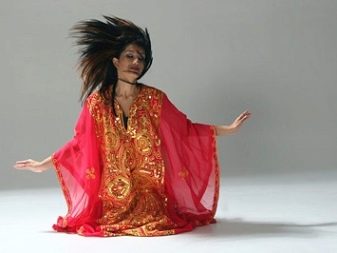
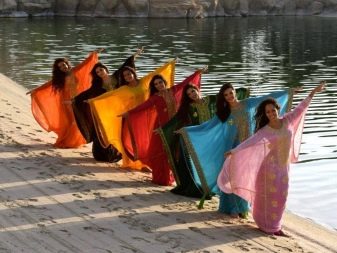
- Bandari. It is very similar to the previous version, only it requires more energetic movements of the head, shoulders, arms, but the hips are less active. It is performed in large groups in a circle. It is important to understand that this is a perky, fun, uncomplicated dance for everyone.
This is not all, and it is not necessary to master all directions in order to feel like the goddess of oriental dance. Moreover, one will fall in love with one, and one will want to improve in it.
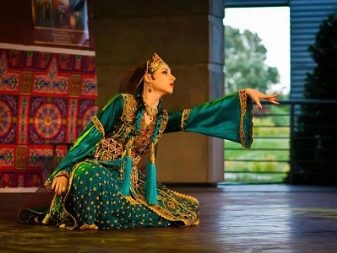
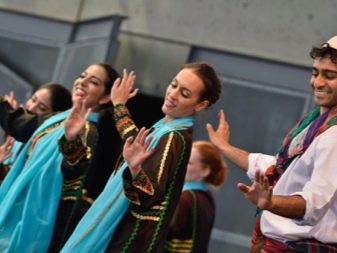
Technique
Oriental dance includes three unities: taksim, fast dance and shaking.
- Fast. And this is more like training for strength and endurance, but you can't show it - everything should have lightness and grace, for which they love oriental dances. This is precisely the basis. There will be hips, eights, plates, and chest movements.
- Slow. Taksim is the slow part of the dance. The dancer controls the body, staying in one place, all movements are static. This part is always very fluid, but it is very interesting because it shows the improvisational skills of the dancer. There are no bright percussion instruments in this part of the dance, or rather, they sound very quiet. In taksim, you can show your grace and plasticity, the beauty of slow and bewitching movements. And it is very important to have time to finish dancing at the moment when the music has stopped - the artist herself may not know when this will happen. In this part, there are many smooth movements of the arms, eights of the hips, small and large circles, shaking.
To show the uniqueness of your style, all the trump cards of improvisation, slow technique is especially important.
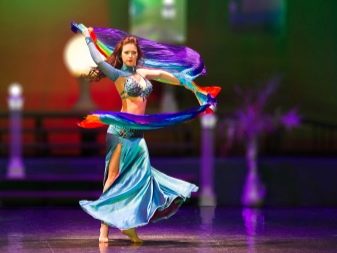
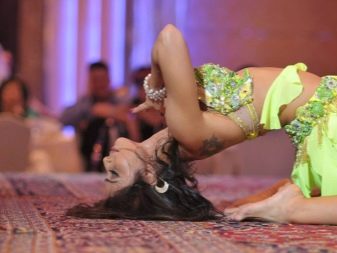
Who are they suitable for?
One of the main advantages of oriental dances is that you can learn as an adult without any preparation. Age doesn't matter. A figure too. Dancing is considered an activity that helps to spend extra calories, therefore, losing weight or gaining more beautiful forms is the best "side" effect of oriental dancing.
Who is recommended to do them:
- everyone who wants to dance, but is afraid to start in adulthood;
- girls (children) who are attracted by oriental culture, beautiful outfits;
- those who, in principle, are interested in the aesthetics of the Middle East.
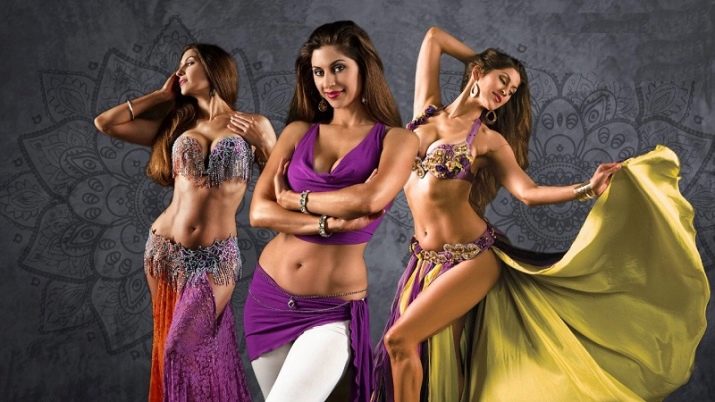
What to hide, many women associate a hobby for oriental dancing with a desire to increase their sex appeal. And this is quite understandable and fair. The body becomes more flexible, the gait is lighter, the movements are more flexible. Classes also include breathing exercises, because the whole body is saturated with oxygen. And also oriental dances help to get rid of complexes. The flow of blood to the pelvic organs, which occurs at the time of exercise, eliminates stagnant processes, helps prevent many female diseases.
This is a good preparation for pregnancy, childbirth, and a good way to recover from them. Therefore, the healing effects of oriental dances are definitely present.But there are those who should not choose such a pastime. It is believed that people with severe flat feet, diseases of the spine (hernias), varicose veins, some cardiopathologies and other diseases do not need to engage in "belly dance", the possibility of activity in which should be discussed with a doctor.


How to dance?
There are lessons for beginners on the Internet, and the first acquaintance with dance can be arranged at home. At least in order to understand whether it is pleasant in practice, whether it is a pleasure to learn new exercises. We will find out what basic elements you can master at home.
- Twisting the hips. They turn in each direction, and the body remains motionless.
- Eights with hips. The number 8 is simply displayed by the hips.
- Wave. The thighs outline a circle in the frontal and lateral regions.
- Breast crunches. The head and hips are motionless, and the ribcage moves in different directions.
- Eights are breastfeeding. The number 8 is also written out in any direction. Waves by the chest are made according to the same principle as by the hips.
- Rocking chairs. Legs - foot-width apart, knees - softened, bent, pelvis - slightly forward, arms - to the sides, parallel to the floor. And the chin is in the same position. Slightly in turn, you need to start bending your knees.
- Dome. The belly stretches and swells to the beat of the music.
- Shimmy. Bend both knees, straighten your right leg to lift your right thigh up. Tighten the pelvis to the chest, while the upper body is not involved. The heels must not be lifted off the ground. Then it is lowered, and the same is done with the left thigh.
- Cuttlefish. The right thigh is twisted forward, where the body weight is transferred, and the figure eight is entered. The same twist is already with the left thigh, the leg is slightly pulled back, the stomach needs to be reduced.
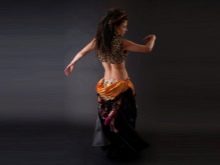
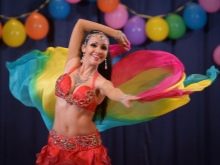
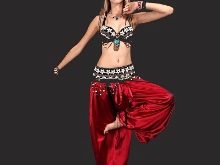
This is not even the basics, but the elements that need to be learned in order to continue studying. Theoretically, you can do it yourself and correctly - a training video to help. But a serious dance staging is training with a trainer.
Training is possible both in the context "for oneself" and for subsequent participation in competitions. By the way, after 50 it is also possible - championships involve different age categories.
In the next video, you will find the first lesson for beginners.
Which look is right for you?
Costumes for oriental dances are a huge part of the whole performance, without them the number will not be spectacular. Here are some tips for choosing a suit and hairstyle from the pros.
- You need to soberly assess your figure, understand what should be emphasized and what not to emphasize.
- Tall women divide the figure with horizontal elements, be it a print on fabric, an expressive bodice, a contrasting belt or bracelets.
- The short ones need vertical elements in the image: draperies, appliques, patterns, one color for the base and skirt.
- If a girl is very thin, you can add volume to her chest and hips - this is large embroidery, ruffles, flounces and even push-up.
- If the element of fire is traced in the idea of the dance, the same colors should be taken: red, orange, bright burgundy.
- Complex colors (like brick and olive) look dull on stage - this is definitely not the key to success.
- The younger the dancer, the more acidic the color can be: both hot pink and light green. By the way, light green and white look good in any light.
- Animal prints look good in a suit for oriental dance.
- Supplex, stretch velvet, chiffon, oil, organza, satin, brocade are well suited as fabrics for "belly dance".
- The traditional costume will consist of a bodice, top, belt and hip scarf, as well as a skirt, trousers / shorts, and shalwar. And many additional accessories. You cannot do without elegant jewelry and eye-catching makeup.
- Dance shoes are either fabric ballet flats, or leather ballet flats, or special dance shoes, or oriental shoes with curved toes.
- Long curvy hair is the best hairstyle. They can be curled, decorated with ribbons, beads, rhinestones. You can use scarves and lace bandages, jewelry.The longer the hair, the more it becomes a dance instrument.
Pleasant impressions from the first lessons and beautiful results!
